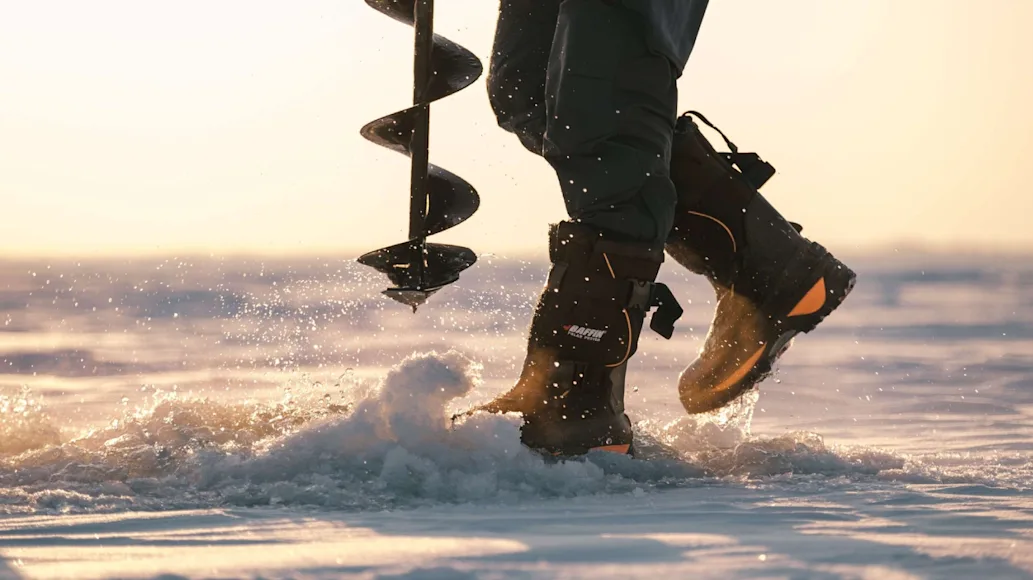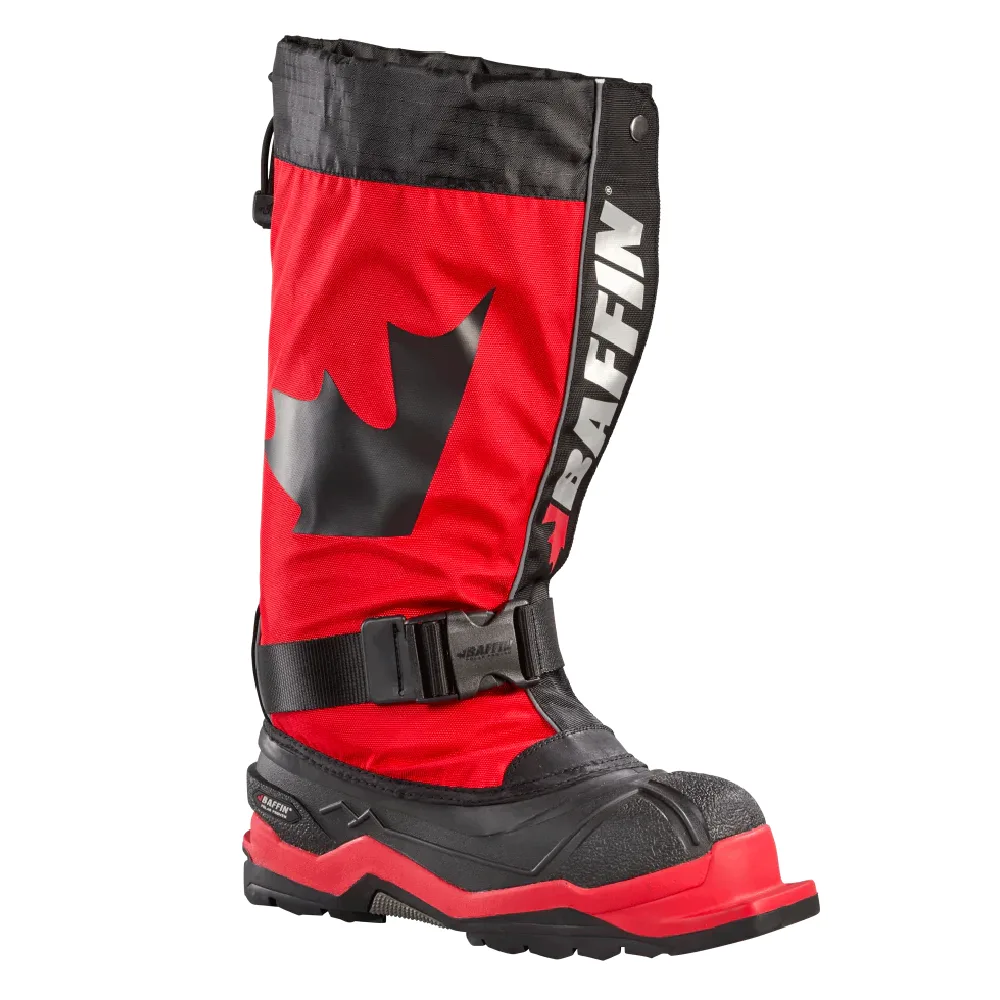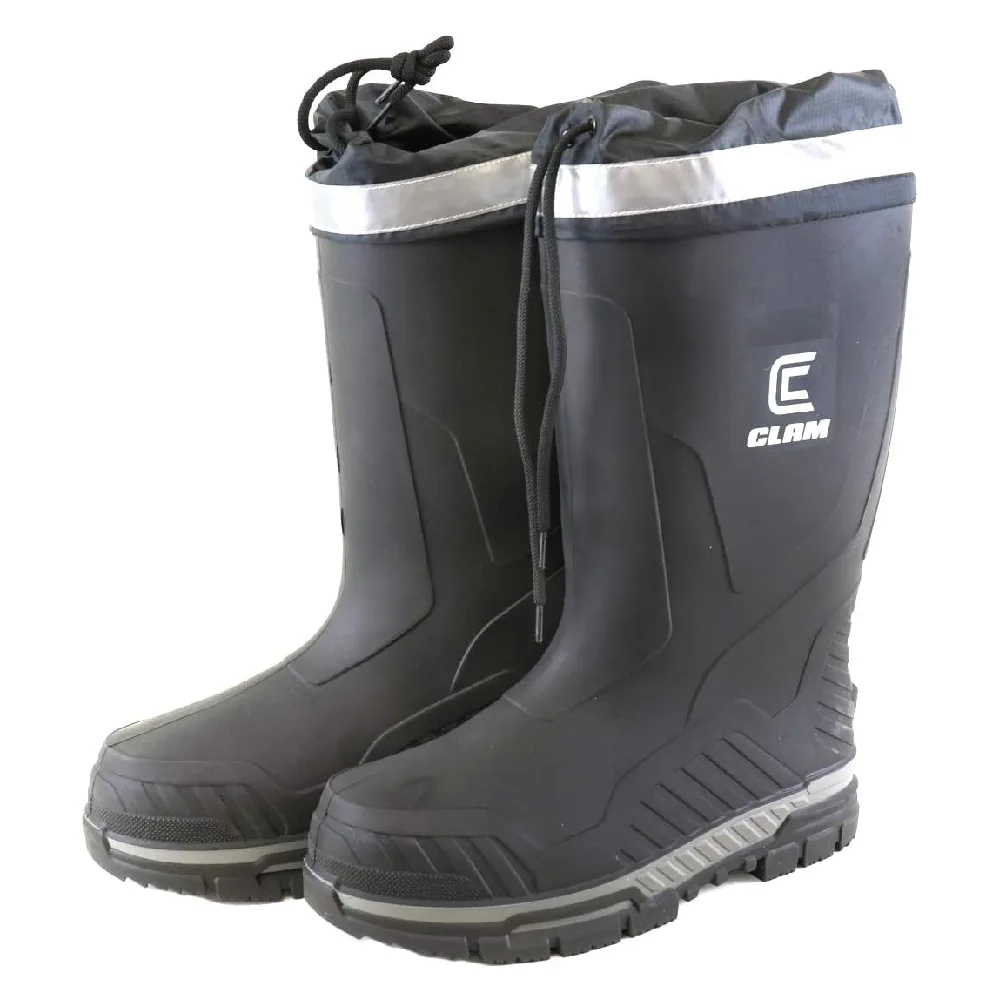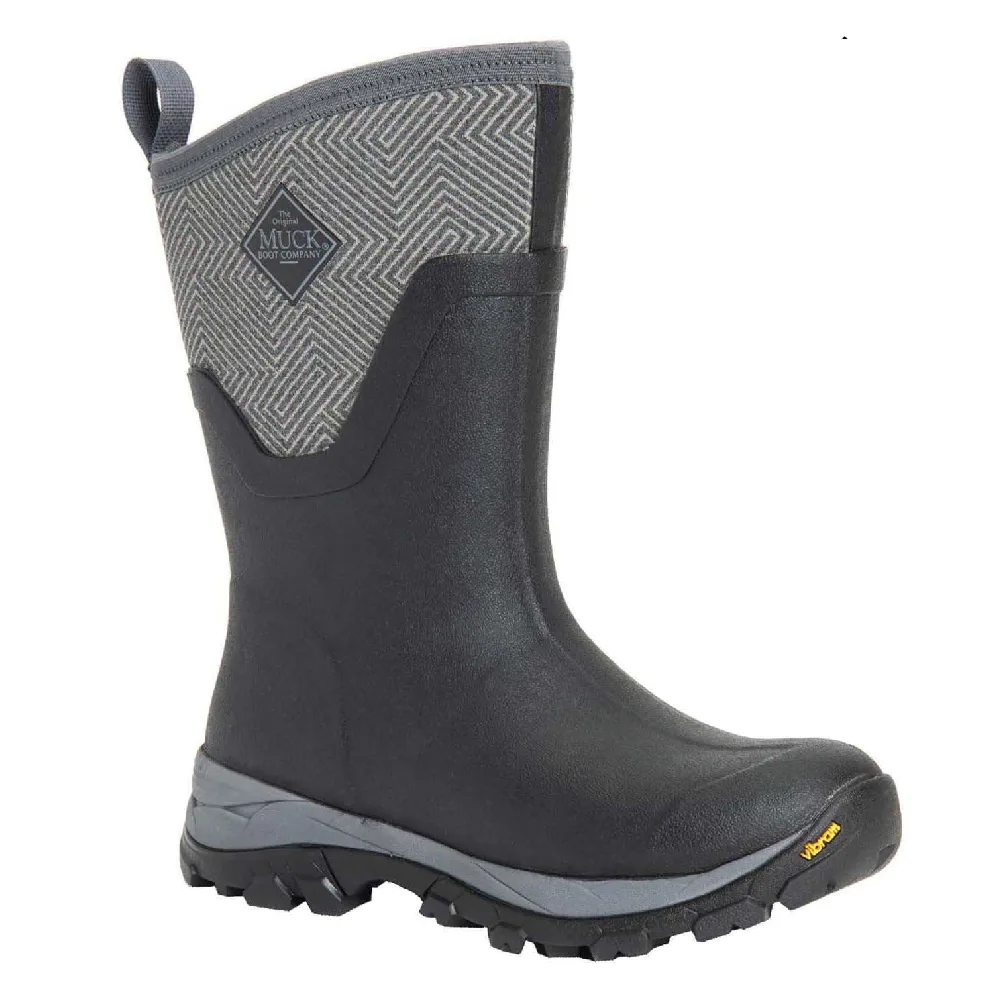We may earn revenue from the products available on this page and participate in affiliate programs. Learn more
Ice fishing boots—next to reels or gloves—are at the bottom of many an ice angler’s list of necessities for a day’s fishing on a frozen waterway. But the only lowermost portion these provisions should be located, however, is the bottommost part of your body.
Keeping your feet warm out on the ice ensures you have an enjoyable day. While choosing the best ice fishing boots for you may seem like a simple imposition, there’s more to it than where the lugged sole meets the frozen water. After all, misery loves cold-footed company. The moment your feet get chilled, it’s too late—your entire body follows suit. Use this guide to find the best ice fishing boots for you so you can concentrate on what counts: catching fish.
Best Overall: Korkors Polar Vortex 1200
Best for Extreme Cold: Baffin Guide Pro III
Best for Women: Muck Boot Arctic Ice Agat
Best for Deep Snow: Clam Sub-Zero X
Best Overall: Korkers Polar Vortex 1200
Specs
Sizes: 8 - 14
Weight: 4 pounds, 4 ounces (size 9)
Color: Black/silver
Height: 11 inches
Pros
Easy on/off
Easiest lacing adjustments
Interchangeable soles
Cons
Shorter than some boots
The Polar Vortex 1200 is a very warm, waterproof, and versatile boot that is light in weight. It is extremely comfortable when walking and sitting still; easy to use with manual-shift quads, and tucks easily into a snowmobile’s footrest. The first thing that stands out is the Boa M4 Fit System that replaces laces. This allows for fast on and off, as well a custom fit that adjusts for the thickness of socks you have on every time you use them. Spin the ratchet knob and the boot tightens evenly; pop the knob out and it loosens up quickly.
Another unique feature is the interchangeable soles. You'll get both a set of SnowTrac rubber lug and a pair of IceTrac studded-rubber lug soles. The latter is fitted with 32 carbide studs per sole for plenty of bite on the ice. Changing out the cleated sole for the rubber lug keeps vehicle floor mats and home entranceways free from damage. There’s 1200g of 3M Thinsulate insulation, as well an aerogel frost barrier footbed underneath for keeping keep feet warm while sitting still. Yet, they won’t overheat your feet when walking.
Best for Extreme Cold: Baffin Guide Pro III
Specs
Sizes: 8 - 14
Weight: 8 pounds, 5 ounces (size 10)
Color: Red/black
Height: 17 inches
Pros
Nearly knee high
Flexible upper materials
Breathable
Cons
Pricey
Baffin’s Guide Pro III has been tested and proven in the extremes of the North and South Poles. It's tremendously insulated with a built-in gaiter to keep snow out and your lower extremities warm. The modern-day waterproofing technology repels water, yet it remains breathable. This keeps feet and calves dry from water splash when using a power auger or when stomping through deep snow. It also allows any perspiration to escape.
The outsole of this boot is made of Polar Rubber, which stays pliable at subzero temperatures for greater grip. The B-Tek insulation is form fitting to the foot, to capitalize on heat retention and foot comfort. There’s even a reinforced-steel 3-pin toe appendage for utilizing cross-country skis when trudging through the bush when getting back to remote lakes.
Best for Women: Muck Boot Arctic Ice Agat
Specs
Sizes: 5 - 11
Weight: 2 pounds (size 8)
Color: Black/pink accents
Calf circumference: 15 inches
Pros
Easy walking
Flexible materials
100% waterproof
Cons
No removable liner
Might be tight for those with large calves
Muck Boot Company’s Arctic Ice rubber boots are sized and shaped to create the right fit for a woman’s foot. These ice fishing boots are versatile and work well for other winter recreation, such as snowshoeing and small game hunting. The design helps manage moisture due to condensation and sweat, which can cool off feet just as easily as easily as water entering the boot. This also helps with odor control when the day is done.
This boot’s grip on slippery surfaces is better than the average winter footwear due to its Vibram Artic Grip A.T. sole. (Note: Ice cleats always recommended when ice fishing.) The inner lining is soft and lightweight, yet its insulation value is rated down to -40˚ Fahrenheit. The upper boot fits snug to the shin to keep water and snow out. This could hinder the tucking in of outerwear, however.
Best for Deep Snow/Slush: Clam Sub-Zero X
Specs
Sizes: 8 - 14
Weight: 4 pounds, 4 ounces (size 10)
Color: Black/charcoal
Pros
Seamless construction
No laces
Heal kick tab eases removal
Cons
Some condensation may occur
Even if damp, wool retains heat. The removable wool liners in Clam’s Sub-Zero X boots make drying out perspiration—inevitable after a full day on the ice—very easy. The wader-like construction means that water cannot penetrate under any circumstance. They are very light weight for a vulcanized rubber, well-insulated boot.
Tighten the drawstring at the top and the material keeps snow out and helps keep body heat in. This is a great boot for anglers sitting in portable ice shanties with no floor, or for those who hop hole to hole throughout the day. These are one of the better boots for late-season ice fishing, when shoreline snows start to melt and slush accumulates on the ice.
How We Tested Ice Fishing Boots
After spending the last 50-something years in the snowbelt of Lower Michigan, I’ve seen the technology used to keep your tootsies toasty transform tremendously. As a kid, keeping one’s feet dry meant wrapping them in Wonder Bread bags after donning socks, then sliding them into whatever winter boot was on sale at the local five & dime that year. Later on, fishing trips on a frozen lake meant donning moon boots (you kids can Google that one up). These were more of a sponge in the shape of footwear and absorbed every ounce of moisture they could muster.
A lot has changed since those days. Subsequently, I’ve spent countless hours on hard ice, in snow on the ice, in slush on the ice, as well in temperatures from just barely freezing to 40-below zero. The following is what I delved into when critiquing the best ice-fishing boots:
Insulation: It’s not just the amount that counts, but where it’s located in the boot. What’s between your feet and the soles is equally, if not more so, as important as the sides and top.
Ease of putting them on and taking them off: Dressing for an ice fishing excursion is about as close to preparing for a mission to the moon as most of us will ever get. By the time you get to your boots, you may be starting to sweat, which is not ideal. Struggling to put on a pair of boots is the last thing you want to do, as well. And taking them off without the help of someone else is just as important.
Durability: No wants to buy a new pair of ice fishing boots every year. The construction and longevity of the footwear was a top consideration, too.
Comfort: Warm feet doesn’t necessarily mean comfortable feet. Thoughts on high-quality insoles, weight of the boot and potential for chafing against the calf made the list, in addition.
What to Consider When Choosing Ice Fishing Boots
There’s much to ponder when picking the best ice-fishing boots, not only to give you the most bang for your Benjamins, but more so allow you to have the most comfortable, fun day while ice fishing.
Duration
How much of the day do you spend on the ice is one factor. Are you the type of angler that stays out from sunup ‘til sundown? Perhaps you only spend a couple hours holding your ice fishing rod during an average outing. The longer you tend to stay out, the more insulation you’ll want.
Temperature
Don’t overlook the average ambient air temperatures where you ice fish most. In the southern most regions of the ice fishing belt it may rarely get below the freezing mark, let alone to zero. The further north you go, the colder; to the point when it hits zero it feels kind of balmy.
Snow and Slush
The depth of normal snowpack plays a huge roll, as well. Some areas may see thigh-deep snow, where others a wisp blowing across the lake seems like a lot. And the thicker the snow on a frozen waterway the more it pushes the ice down into the lake. If this occurs, water seeps through it, creating slush between the layers.
Transportation
How you get to your fishing location is a factor, too. If you hoof it on foot, flexible, lighter-weight boots are in order. If riding on a quad, side-by-side or snowmobile, heavier boots may be just the ticket. When driving a manual-shift rig, you’ll want ice-fishing boots with reinforcement in key locations.
FAQs
Q: What can I expect to pay for a pair of ice fishing boots? Like any footwear, you really do get what you pay for with ice fishing boots. But this will also depend on how avid an ice angler you are. In general, you’ll be pleased with the quality, comfort and warmth of boots in the $200 to $270 range. Some, however, can cost as much as $500 for the extreme-sport lover. If you’re just getting started in ice fishing, you may find the budget boots will do. And if you find you’re really getting into it, you can always upgrade and use the lesser pair for shoveling the sidewalk.
Q: Should ice cleats be used in conjunction with ice fishing boots, if not already constructed into the soles? This could just be a one-word answer: Yes! But let me elaborate. Ice is, well, ice. Even with snow upon its exterior a lake’s frozen surface isn’t just slippery, but dang near rock hard. Busted bones and whacked out backs have occurred from a slip and fall while trying to enjoy a day on the ice trying to catch dinner. Overall, ice fishing’s not dangerous; but why take the risk.
Q: Can I use snowshoes with ice fishing boots? Yes, you can. But it’s suggested to use them only when going to and from the lake. If there’s no snow on the ice, then, obviously, you won’t need them. If the lake’s got snow deep enough for the need of snowshoes, on the other hand, there’s a good chance there will be slush in the mix. With every step you take, more and more slush will build up on the snowshoes, and soon it’ll feel like you have cinder blocks strapped to your ice-fishing boots, instead. And once the ice builds up on your snowshoes, if you don’t have a means of chipping it all off without damaging them, they’ll be worthless for the hike back to your vehicle.
Final Thoughts
Don’t skimp. No, seriously: Do. Not. Skimp. Buy the best ice fishing boots you can afford to add to your ice fishing gear. You’ll use them for so much more than just ice fishing. Cheap footwear never lasts. Excellence counts. And cold feet aren’t fun.
Why Trust Us
For more than 125 years, Field & Stream has been providing readers with honest and authentic coverage of outdoor gear. Our writers and editors eat, sleep, and breathe the outdoors, and that passion comes through in our product reviews. You can count on F&S to keep you up to date on the best new gear. And when we write about a product—whether it’s a bass lure or a backpack—we cover the good and the bad, so you know exactly what to expect before you decide to make a purchase.








